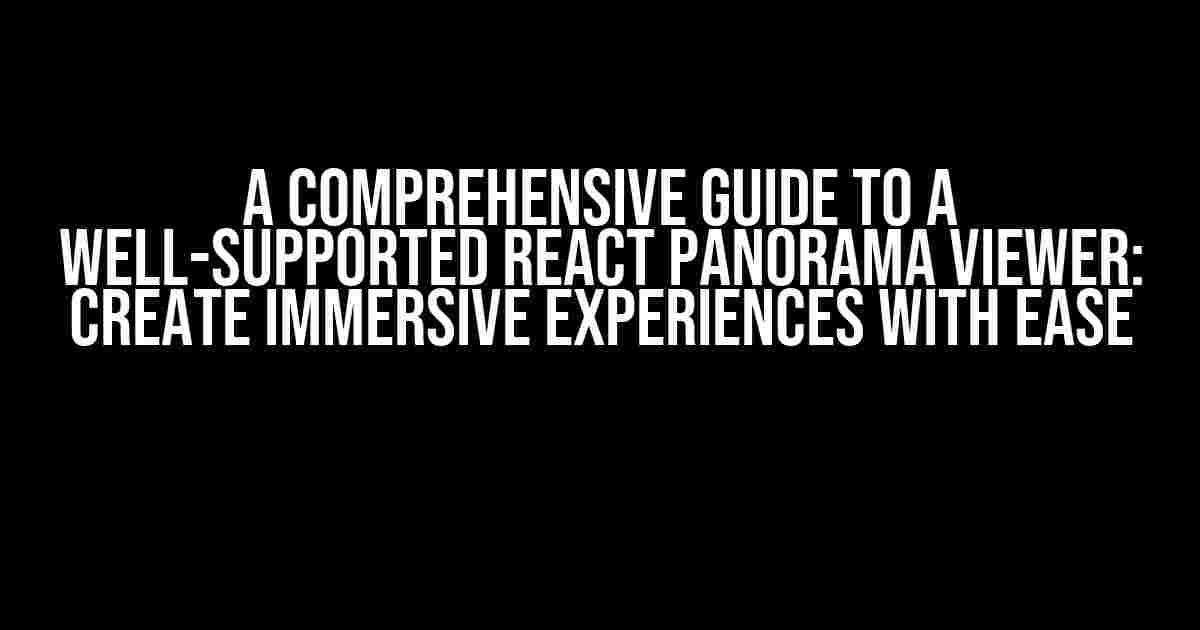Introduction
Immersive experiences have become a staple in modern web development, and React Panorama Viewer is a powerful tool that allows developers to create stunning 360-degree panorama views. However, with great power comes great complexity, and many developers struggle to create a well-supported React Panorama Viewer that meets their needs. In this article, we’ll delve into the world of React Panorama Viewer, exploring its features, benefits, and most importantly, providing step-by-step instructions on how to create a well-supported React Panorama Viewer.
What is a React Panorama Viewer?
A React Panorama Viewer is a JavaScript library that enables developers to create interactive 360-degree panorama views within their React applications. It uses WebGL and Three.js to render the panorama, providing a seamless and immersive experience for users. With a React Panorama Viewer, you can:
- Create stunning 360-degree panorama views for real estate, tourism, and e-commerce applications
- Enhance user engagement and interaction with interactive hotspots and links
- Improve user experience with smooth transitions and animations
Benefits of a Well-supported React Panorama Viewer
A well-supported React Panorama Viewer offers numerous benefits, including:
- Improved User Experience: Provide users with an immersive and engaging experience that sets your application apart from the competition.
- Increased Conversion Rates: Interactive 360-degree panorama views can lead to increased conversion rates and improved sales.
- Enhanced Brand Engagement: Create memorable brand experiences that leave a lasting impression on users.
- Faster Development: With a well-supported React Panorama Viewer, you can focus on developing features rather than building from scratch.
Creating a Well-supported React Panorama Viewer
Now that we’ve covered the benefits, let’s dive into the process of creating a well-supported React Panorama Viewer.
### Step 1: Install the Required Packages
To get started, you’ll need to install the required packages, including React, React Panorama Viewer, and Three.js. Run the following command in your terminal:
npm install react react-panorama-viewer three### Step 2: Create a New React App
Create a new React app using create-react-app:
npx create-react-app my-panorama-app### Step 3: Import the Required Components
In your `index.js` file, import the required components:
import React from 'react';
import { PanoramaViewer } from 'react-panorama-viewer';
import * as THREE from 'three';### Step 4: Create a Panorama Viewer Component
Create a new component for your panorama viewer:
const PanoramaViewerComponent = () => {
const panoramaUrl = 'https://example.com/panorama.jpg';
const hotspots = [
{
id: 1,
x: 100,
y: 100,
z: 100,
url: 'https://example.com/hotspot-1'
},
{
id: 2,
x: 200,
y: 200,
z: 200,
url: 'https://example.com/hotspot-2'
}
];
return (
<PanoramaViewer
panoramaUrl={panoramaUrl}
hotspots={hotspots}
onHotspotClick={(hotspot) => console.log(hotspot.url)}
/>
);
};### Step 5: Configure the Panorama Viewer
Configure the panorama viewer with the required options:
const panoramaViewerOptions = {
controls: {
enabled: true,
zoomSpeed: 2.0
},
renderer: {
antialias: true
},
camera: {
fov: 60,
near: 0.1,
far: 1000
}
};### Step 6: Render the Panorama Viewer
Render the panorama viewer component:
ReactDOM.render(
<React.StrictMode>
<PanoramaViewerComponent />
</React.StrictMode>,
document.getElementById('root')
);Optimizing the Panorama Viewer for Performance
To ensure a seamless and immersive experience, it’s essential to optimize the panorama viewer for performance. Here are some tips:
| Optimization Technique | Description |
|---|---|
| Use Web Workers | Offload computationally intensive tasks to web workers to reduce the load on the main thread. |
| Optimize Image Compression | Use efficient image compression algorithms to reduce the file size and improve loading times. |
| Use Level of Detail (LOD) | Implement LOD to reduce the complexity of the panorama as the user moves away from the center. |
| Enable Antialiasing | Enable antialiasing to reduce aliasing artifacts and improve image quality. |
Common Issues and Solutions
While creating a well-supported React Panorama Viewer, you may encounter some common issues. Here are some solutions:
- Issue: Panorama Viewer not rendering
- Solution: Check the panorama URL and ensure it’s correctly formatted.
- Issue: Hotspots not clickable
- Solution: Verify the hotspot coordinates and ensure they’re correctly aligned with the panorama.
- Issue: Performance issues
- Solution: Optimize the panorama viewer for performance using the techniques mentioned above.
Conclusion
Creating a well-supported React Panorama Viewer requires careful planning, attention to detail, and a solid understanding of the underlying technologies. By following the steps outlined in this article, you’ll be well on your way to creating immersive and engaging 360-degree panorama views that leave a lasting impression on your users. Remember to optimize for performance, troubleshoot common issues, and continuously iterate to improve the user experience.
With a well-supported React Panorama Viewer, the possibilities are endless. Get creative, and let the magic begin!
What’s your experience with React Panorama Viewer? Share your thoughts, tips, and experiences in the comments below!
Happy coding!
Here are 5 Questions and Answers about “Well-supported React Panorama Viewer” in English language with a creative voice and tone:
Frequently Asked Questions
Get clarity on the Well-supported React Panorama Viewer with our comprehensive FAQ section!
What makes a React Panorama Viewer well-supported?
A well-supported React Panorama Viewer is one that is backed by a dedicated team of developers, has an active community of users, and receives regular updates to ensure compatibility with the latest browsers and devices.
How does a well-supported React Panorama Viewer benefit my project?
A well-supported React Panorama Viewer ensures that your project remains stable, scalable, and secure, allowing you to focus on developing an immersive and engaging user experience.
What features should I look for in a well-supported React Panorama Viewer?
A well-supported React Panorama Viewer should offer features like 360-degree view rendering, zoom and drag functionality, customizable UI, and seamless integration with React.
Can I customize a well-supported React Panorama Viewer to fit my project’s needs?
Yes, a well-supported React Panorama Viewer should be highly customizable, allowing you to tailor the UI, layout, and functionality to align with your project’s unique requirements.
How do I know if a React Panorama Viewer is well-supported?
Check for indicators like frequent updates, active community engagement, detailed documentation, and responsive support channels to ensure that the React Panorama Viewer you choose is well-supported.


